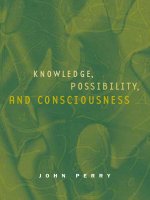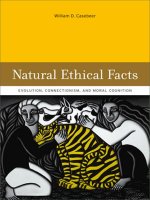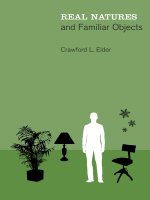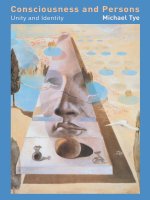the mit press organisms and artifacts design in nature and elsewhere apr 2004
Bạn đang xem bản rút gọn của tài liệu. Xem và tải ngay bản đầy đủ của tài liệu tại đây (1.06 MB, 196 trang )
In Organisms and Artifacts Tim Lewens investigates
the analogical use of the language of design in
evolutionary biology. Uniquely among the natural
sciences, biology uses descriptive and explanatory
terms more suited to artifacts than organisms.
When biologists discuss, for example, the purpose
of the panda’s thumb and look for functional
explanations of organic traits, they borrow from
a vocabulary of intelligent design that Darwin’s
findings could have made irrelevant over a
hundred years ago. Lewens argues that examin-
ing the analogy between the processes of evolution
and the processes by which artifacts are created—
looking at organisms as analogical artifacts—
sheds light on explanations of the form of both
organic and inorganic objects. He argues further
that understanding the analogy is important for
what it can tell us not only about biology but about
technology and philosophy.
In the course of his argument Lewens
discusses issues of interest to philosophers
of biology, biologists, philosophers of mind, and
students of technology. These issues include
the pitfalls of the design-based thinking of adapta-
tionism, the possible conflict between selection
ORGANISMS
AND
ARTIFACTS
Design in Nature and Elsewhere
Tim LEWENS
I find the work extremely original and philosophically quite sound. Lewens’s work
successfully removes a lot of the irrelevant issues that contrast material theories of
evolution by natural selection with notions of human design.”
Richard LEWONTIN, Alexander Agassiz Research Professor, Harvard University
I had long thought that the topic of function in biology was exhausted. Organisms and
Artifacts, Tim Lewens’s splendid new book, shows that I was quite wrong. Lewens
unites a deep understanding of biology with a keen nose for a philosophical problem,
and he has produced a work that is insightful and (just as important) highly inter-
esting. This book will give an old problem really new life, and must be the starting point
for all future discussion.”
Michael RUSE, Lucyle T. Werkmeister Professor of Philosophy, Florida State University
ORGANISMS AND ARTIFACTS Lewens
The MIT Press
Massachusetts Institute of Technology
Cambridge, Massachusetts 02142
e
ORGANISMS
AND
ARTIFACTS
Tim LEWENS
e
Design in Nature and Elsewhere
“
“
,!7IA2G2-bccgba!:t;K;k;K;k
0-262-12261-8
explanations and developmental explanations, a
proposed explanation of biological function, and
prospects for an informative evolutionary model
of technological change. Emerging from these
discussions is an explanation of the use of the
vocabulary of intelligence and intention in biology
that does not itself draw on the ideas of intelli-
gent design, which will be of interest in the on-
going debate over intelligent design creationism.
Tim Lewens is University Lecturer in
History and Philosophy of Science at Cambridge
University.
Life and Mind series A BRADFORD BOOK
Cover drawing: Vaucanson’s duck (Eco and Zorzoli, The Picture
History of Inventions. Macmillan, 1963).
Jacket design by Emily Gutheinz.
45629Lewens 3/24/04 12:01 PM Page 1
Lewens-79044 book October 15, 2003 12:19
Organisms and Artifacts
Lewens-79044 book October 15, 2003 12:19
Life and Mind: Philosophical Issues in Biology and Psychology
Kim Sterelny and Robert A. Wilson, editors
Cycles of Contigency: Developmental Systems and Evolution
Susan Oyama, Paul E. Griffiths, and Russell D. Gray, editors, 2000
Coherence in Thought and Action
Paul Thagard, 2000
Evolution and Learning: The Baldwin Effect Reconsidered
Bruce H. Weber and David J. Depew, 2003
Seeing and Visualizing: It’s Not What You Think
Zenon Pylyshyn, 2003
The Mind Incarnate
Lawrence A. Shapiro, 2004
Organisms and Artifacts: Design in Nature and Elsewhere
Tim Lewens, 2004
Lewens-79044 book October 15, 2003 12:19
Organisms and Artifacts
Design in Nature and Elsewhere
Tim Lewens
A Bradford Book
The MIT Press
Cambridge, Massachusetts
London, England
Lewens-79044 book October 15, 2003 12:19
© 2004 Massachusetts Institute of Technology
All rights reserved. No part of this book may be reproduced in any form by any
electronic or mechanical means (including photocopying, recording, or informa-
tion storage and retrieval) without permission in writing from the publisher.
This book was set in Sabon by Interactive Composition Corporation and was
printed and bound in the United States of America.
Library of Congress Cataloging-in-Publication Data
Lewens, Tim.
Organisms and artifacts : design in nature and elsewhere / Tim Lewens.
p. cm. — (Life and mind)
“A Bradford Book.”
Includes bibliographical references and index.
ISBN 0-262-12261-8 (hc: alk. paper)
1. Biology—Philosophy. I. Title. II. Series.
QH331.L533 2004
570
.1—dc22
2003061768
10987654321
Lewens-79044 book October 15, 2003 12:19
Time out of mind it has been by way of the “final cause,” by the teleological
concept of end, of purpose or of “design,” in one of its many forms (for its moods
are many), that men have been chiefly wont to explain the phenomena of the living
world, and it will be so while men have eyes to see and ears to hear withal.
—D’Arcy Thompson, On Growth and Form
It [teleology] is important, but my sense is that there is a feeling that basically
the subject is worked out. Natural selection produces design-like objects and so
function talk is appropriate. . . . Of course, as always in philosophy there is scope
for all those bizarre counter-examples to which we all seem so addicted . . . ; but
frankly this is the stuff of PhD theses and not the real world.
—Michael Ruse, “Booknotes,” Biology and Philosophy
Lewens-79044 book October 15, 2003 12:19
Lewens-79044 book October 15, 2003 12:19
Contents
Preface ix
1 Meaning and the Means to an Understanding of Ends 1
2 Why Is an Eye? 21
3 Adaptationism and Engineering 39
4OnFive “-Isms” 67
5 Function, Selection, and Explanation 87
6 Deflating Function 119
7 Artifacts and Organisms 139
References 167
Index 177
Lewens-79044 book October 15, 2003 12:19
Lewens-79044 book October 15, 2003 12:19
Preface
An outsider who looks at evolutionary biologists’ language might think
they are behind the times. What is all this talk of solutions adopted by
species to deal with the problems laid down by environments? Why do
biologists persist in asking what the peacock’s tail, or the earwig’s second
penis, are for? Shouldn’t they have stopped talking about the purpose
of the panda’s thumb over a hundred years ago? All this talk smacks of
intelligent design—of artifacts, not of organisms. Yet Darwin taught us
(or maybe it was Hume) that organisms are not artifacts. What is more,
it is often the biologists keenest to distance themselves from any non-
sense about intelligent design who are nonetheless the first to trumpet
the excellence of design in nature, and who look most eagerly for func-
tional explanations for any and all organic traits or behaviors. Could it
be that there are vestiges of natural theology lurking in this language of
design? This book is an investigation of an analogy—the analogy between
the processes of evolution and the processes by which artifacts are cre-
ated. I try to show how looking at the two domains together can shed
light on how we should explain the form of both organic and inorganic
objects, and how our conclusions about natural design can inform var-
ious philosophical projects. It is important to understand the organism/
artifact analogy for what it can tell us about biology, technology, and
philosophy.
This book is addressed primarily at philosophers of biology; this said,
I hope also that real biologists, students of technology, philosophers of
mind—even some civilians—will find lots to interest them. Chapter 2
looks at biology alone, yet its conclusions are used as foundations for
work done in all the remaining chapters, and all types of reader are
Lewens-79044 book October 15, 2003 12:19
x Preface
encouraged to look at it. Biologists will perhaps be most interested in
this second chapter, and also in chapters 3 and 4, in which I discuss
how the design-based thinking of adaptationism can lead us astray, how
selection explains adaptation, and how selection explanations and devel-
opmental explanations might come into conflict. Philosophers of mind
will get most from chapters 5 and 6, where I approach the old-fashioned
question of how to understand functions, and I put forward a nonhistori-
cal, deflationary, analysis of biological function. Historians of technology,
and perhaps other students of the made world, may be most interested in
the final chapter, where I look to the prospects for an informative evolu-
tionary model of technological change. Finally, a thread runs through the
book that offers an explanation that does not itself look to intelligence
as the justification for the appearance in biology of a vocabulary that is
saturated with intelligence and intention. This explanation closes off one
set of routes to intelligent design creationism, and readers interested in
that debate should also find this work useful.
Parts of the book, or at least some of its arguments, have appeared
elsewhere. Chapter 1 draws from “No End to Function Talk” (Studies
in History and Philosophy of Biological and Biomedical Sciences 32,
2001) and “Function Talk and the Artifact Model” (Studies in History and
Philosophy of Biological and Biomedical Sciences 31, 2000). Chapter 2
borrows some arguments from a paper I coauthored with Denis Walsh
and Andr
´
e Ariew called “The Trials of Life” (Philosophy of Science 69,
2002). Chapter 3 is an augmented version of “Adaptationism and Engi-
neering” (Biology and Philosophy 17, 2002), and I am grateful to Kluwer
Academic Publishers for permission to reproduce material from that ar-
ticle here. Chapter 7 includes some arguments that were first aired in
“Darwinnovation!” (Studies in History and Philosophy of Science 33,
2002).
There has been a good deal published in the last couple of years on
the topics addressed in this book, and I have not been able to take ac-
count of all of it. One book—Peter McLaughlin’s (2001) What Functions
Explain—came to my attention only as the final draft was being prepared.
I have tried to give brief indications in chapter 5 of some of the points
over which we agree and differ, but I have not had time to integrate a
discussion of McLaughlin’s views in a more comprehensive way.
Lewens-79044 book October 15, 2003 12:19
Preface xi
There are many people without whose help this book would have been
even worse than it is. My first and greatest debt is to Nick Jardine, who was
my supervisor when Organisms and Artifacts was a Ph.D. dissertation.
Nick is an ideal supervisor: always encouraging, always willing to make
time to read work, and full of the most helpful and insightful comments.
The Department of History and Philosophy of Science in Cambridge is
a wonderful place to have worked over the last five years. I am grateful
to Joanna Ball, Anjan Chakravartty, Jim Endersby, Marina Frasca-Spada,
Anandi Hattiangadi, Tamara Hug, Martin Kusch, Peter Lipton, Helen
Macdonald, Neil Manson, Hugh Mellor, Greg Radick, Matthew Ratcliffe,
David Thompson, and Jill Whitelock for various combinations of advice,
criticism, support, and friendship.
A large proportion of an early draft was written during the academic
year 1999 to 2000, when I was a visiting student in the Centre for
the Philosophy of Natural and Social Sciences at the London School of
Economics. At the LSE I would like to thank Helena Cronin, Oliver Curry,
Dylan Evans, Nicholas Humphrey, and Richard Webb for comments on
talks I gave there.
Many people outside Cambridge and the LSE have been exception-
ally generous in providing comments on my work and assorted ideas.
Andr
´
e Ariew, David Buller, Paul Sheldon Davies, John Dupr
´
e, Peter
Godfrey-Smith, Paul Griffiths, Richard Lewontin, Mohan Matthen, Joel
Mokyr, Elliott Sober, and Chris Stephens all deserve thanks. Denis Walsh
merits special mention for comment and correspondence beyond the call
of duty. I’m grateful to Kim Sterelny and Rob Wilson for taking on the
manuscript at the MIT Press, and especially to Rob Wilson and an anony-
mous reader from MIT for some very helpful comments on the penulti-
mate draft.
For financial support I am grateful to the Arts and Humanities Research
Board, to the Raymond and Edith Williamson Fund, to Corpus Christi
College, and to Clare College. My mum and my sister kindly helped with
proofreading over Christmas dinner. I also owe personal debts to Cesare
Hall, Annette van der Kolk, and Emily Roche.
Lewens-79044 book October 15, 2003 12:19
Lewens-79044 book October 15, 2003 12:23
1
Meaning and the Means to an Understanding
of Ends
1.1 Design in Nature
Biology is unique among the natural sciences in its use of a family of con-
cepts that might seem better suited to the description and explanation of
artifacts than the description and explanation of organisms. Artifacts are
objects made by intelligent agents; organisms—most of them, at least—
owe their construction to no agent. When we think about artifacts of all
kinds—shoes, ships, sealing wax—we find it natural to ask what might
be their functions, and the functions of their parts, what problems they
were made to solve, and so forth. Biologists, and evolutionary biologists
in particular, use a similar vocabulary when they describe and approach
the organic world. They ask what the function of the stiff-legged jumping
behavior (called “stotting”) of Thompson’s gazelles might be; they con-
jecture that the bony plates on the back of Stegosaurus had the purpose
of regulating heat; they suggest that the fragile second penises of male
earwigs snap off inside the vagina in order to prevent fertilization from
other males; they ask what evolutionary problems our hominid ancestors
might have faced in the Pleistocene, and what solutions our species might
have found to meet them.
The vocabulary of intelligent design—the vocabulary of problems, so-
lutions, purpose, and function—might seem to presuppose the existence
of an intelligent designer. The human sciences may speak of purposes
and problems addressed by social institutions; that is no surprise, for
the human sciences range over systems that contain intelligent designers.
The physical sciences generally admit no intelligent designer into their
worldview; correspondingly, physicists do not speak of the purposes of
Lewens-79044 book October 15, 2003 12:23
2 Chapter 1
electrons, and chemists do not ask what benzene rings were designed for.
Thus biology is in an awkward position: it makes free with a vocabulary
of design, even though modern biology recognizes no intelligent designer
as the artificer of the species.
In summary, many biologists adopt what I call the artifact model of
nature: they talk of organisms as though they were designed objects. An
examination of the artifact model answers questions that are of as much
interest to biologists, students of technology, and philosophers of mind
as they are to philosophers keen to understand biological explanation.
Much of the debate over adaptationism, for example, has been framed as
a question of whether it is right to assume that organisms can be divided
into traits each with its own function, in the same way that we might try
to draw an exploded diagram of a car that assigns discrete functions to its
parts. Developmental biologists have argued that a focus on function has
led us to ignore some of the most important factors affecting form. More
broadly, the investigation of the analogy between evolution and the design
process has been thought by some to yield important insights regarding
changes in technology itself. And philosophers of mind have thought that
an account of how hearts can be supposed to pump blood, even though
they may fail to do so, could yield a wholly unmysterious account of how,
for example, beliefs can be supposed to represent cows, even though such
a belief may fail to represent its object accurately.
This book addresses what I take to be the most pressing questions raised
by the phenomena of artifact talk in biology. Such questions include: what
explains the ability of biologists to use such a vocabulary? Are the terms
they use mere metaphors that trade on superficial similarities between the
appearance of organisms and artifacts, or are there close analogies be-
tween the processes that go into the construction of each? Might we be
misled by approaching organisms as though they are collections of more
or less well-designed solutions to environmental problems? Can such a
framework give us a strong predictive engine for the generation of hy-
potheses about the workings of plants and animals—even of the human
mind? Might the kinds of norms that we appear committed to—in speak-
ing of what traits are supposed to do—be appropriate to solve problems
in the philosophy of mind? How should we explain the appearance of
artifact talk in biology and its absence in chemistry and physics? Can the
Lewens-79044 book October 15, 2003 12:23
Meaning and the Means to an Understanding of Ends 3
function and design of artifacts themselves be approached from an evo-
lutionary perspective? Most recent work in this area has been concerned
with giving an analysis of the concept of biological function as it appears
in biological journals. This is certainly an important job, and it forms a
part of the work of this book; however, we can already see that such a
narrow inquiry into function by no means exhausts the tasks of evaluating
and understanding the artifact model.
On the face of it, there are quite simple answers to most of the ques-
tions I’ve just raised. The evolutionary process bears deep similarities to
the process of intelligent design. It is these deep similarities that explain
and justify the appearance of the same vocabulary in both domains. Just
as a designer chooses her materials to fashion an object to meet her prob-
lems, so nature selects traits to fashion an organism to meet problems laid
down by the environment. Natural selection thereby plays a role analo-
gous to intentional choice, and natural selection is what grounds various
claims about function and design in the natural world. Since selection
works only on organisms that reproduce themselves, it is selection that
explains why artifact talk features in biology alone, and not in the physical
sciences. Selection gives traits norms that should be met; hence selection
can underpin normative function claims of the sort intended to ground
projects to naturalize content in the philosophy of mind.
I will argue that such a picture is almost completely mistaken. There are
deep similarities between the processes that go into the construction of
organisms and artifacts; however, although these can help to explain why
both types of objects enjoy a gradual accumulation of useful traits over
time, it is a mistake to think that natural selection is a good analogue to
the intentions of a designer. And it is the internal constitution of biological
items, not the fact that selection acts only on biological items, that best
explains the appearance of artifact talk in biology alone.
Much of the argument for these propositions turns on a demonstra-
tion of just what natural selection is. Natural selection is essentially a
population-level, statistical phenomenon. Intentions, on the other hand,
can have influence on individual entities. This does not mean that any
other element of the evolutionary process yields a better analogue to in-
tention that might instead be used to ground claims about function or
design. We have a choice over just how we wish to tighten up function
Lewens-79044 book October 15, 2003 12:23
4 Chapter 1
talk in biology, depending on what incongruities with our talk of arti-
facts we are prepared to tolerate. I suggest that function claims in biology
are best understood quite simply as claims about contributions to fitness.
However, whatever option we choose, the failure of biological processes
to yield a function concept that closely matches the connotations of arti-
fact functions puts limits on the burdens such a concept can bear.
The work of this book also has an impact on debates about creationism.
What falls out from its treatment of artifact talk in biology, in terms
of the constitution of organic nature and the processes of survival and
reproduction, is an explanation of the use of language admittedly laden
with connotations of intelligent design. No intelligent designer is needed
to make sense of artifact talk.
1.2 Why Is Teleology So Boring?
I will give a map of the structure of this book toward the end of the chapter.
First, I should say a little about my choice of topic. There seems to be a
feeling among many of the most prominent philosophers of biology that
the problem of teleology is a boring one, either because it has already
been solved, or because there is no real problem beyond being clear about
what one intends when one speaks of “function”; or, because the debate is
fruitless, consisting for the main part in the exchange of intuitions about
whether one would use the word “function” in certain artificial imaginary
scenarios.
Let me give three examples. First, Michael Ruse, in the paragraph that
forms one of the epigraphs to this book, tells us that the problem of teleol-
ogy “is worked out. Natural selection produces designlike objects and so
function talk is appropriate” (Ruse 1996, p. 284). The idea that there is
little left to say on the subject is supported by the fact that teleology is one
of the very few topics in philosophy where there is anything resembling
a consensus. Almost all contributions to the functions debate over the
past twenty years have consisted in refinements of Wright’s (1973) etio-
logical analysis. Examples of such approaches include papers by Neander
(1991a,b), Griffiths (1993), Kitcher (1993), and Godfrey-Smith (1993,
1994) to name just a few. Two recent collections—Buller (1999) and Allen,
Bekoff, and Lauder (1998)—are dominated by etiological analyses. This
Lewens-79044 book October 15, 2003 12:23
Meaning and the Means to an Understanding of Ends 5
said, the most recent work on the topic (Ariew, Cummins, and Perlman
2002; Davies 2001; McLaughlin 2001) shows signs that some are moving
away from the etiological consensus.
The basic innovation of recent etiological accounts has been to supple-
ment Wright’s analysis with an explicit reference to natural selection, and
recent papers tend to argue only over just what the appeal to selection
should look like. So while Wright’s analysis tells us that the function of
some item is what it does to explain why it is there, newer etiological
analyses tell us, basically, that a biological item’s function is what tokens
of that type did in the recent past that caused them to be selected.
For Ruse it seems that the functions question is a significant one, but it
has become boring because it has been answered successfully. It is the non-
trivial fact that natural selection produces designlike objects that means
that function talk is appropriate. Had selection not had this character,
function talk would have been a mistake. A comment by Elliott Sober
hints at a second type of complaint: “If function is understood to mean
adaptation, then it is clear enough what the concept means. If a scientist or
a philosopher uses the concept of function in some other way, we should
demand that the concept be clarified” (Sober 1993, p. 86). Sober’s appar-
ent fatigue is, like Ruse’s, partly a result of the thought that the problem
has been solved—after all, most philosophers and biologists seem to agree
that the analyses of function and adaptation should match—but it also
expresses some puzzlement about why we should think there is a serious
philosophical problem of functions at all. We need only be clear in saying
what we mean by “function” in some context, and that is that. Sober’s
problem, then, seems quite different to Ruse’s. For Ruse, the problem
of teleology seems to be the substantive one of vindicating a potentially
illegitimate vocabulary. For Sober, it seems to be one of giving clarity to
words that are ambiguous.
Finally, David Hull (1998) characterizes the debate somewhat differ-
ently again. Hull is bored because he thinks of the literature on functions
as a form of conceptual analysis—a project which he characterizes as
the search for the meaning of some phrase like “S knows that P.” One
philosopher proposes a set of necessary and sufficient conditions to cap-
ture the use of the phrase, and other philosophers respond by concocting
more or less elaborate scenarios in which the analysis fails to match with
Lewens-79044 book October 15, 2003 12:23
6 Chapter 1
their intuitions regarding whether the word should really be used in that
scenario or not. The analyst responds by modifying the analysis, or by as-
serting, like Nissen (1997, p. 215), that the other philosopher’s intuitions
“are just wrong.”
The functions debate certainly has been conducted in this way by some
protagonists. One hears what Bigelow and Pargetter (1987) memorably
call “the dull thud of conflicting intuitions” in the following passages
from Wright and Kitcher, respectively:
If a small nut were to work itself loose and fall under the valve adjustment screw
in such a way as to adjust properly a poorly adjusted valve, it would make an
accidental contribution to the smooth running of that engine. We would never
call the maintenance of proper valve adjustment the function of the nut. (Wright
1973, p. 63)
Unbeknownst to you, there is a connection that has to be made between two parts
if the whole machine is to do its intended job. Luckily, as you were working, you
dropped a small screw into the incomplete machine, and it lodged between the two
pieces, setting up the required connection. I claim that the screw has a function,
the function of making the connection. But its having that function cannot be
grounded in your explicit intention that it do that, for you have no intentions
with respect to the screw. (Kitcher 1993, p. 380)
These are not peripheral to the philosophers’ accounts; the intuitions
they express dictate how their theories of function are formulated.
Perhaps some forms of conceptual analysis are legitimate. Thus, on
some views of the meaning of scientific terms, we see meaning as deriving
from the roles of those terms in the theories in which they feature. Now on
this view, to say what the role of terms like “function” is in biology is also
to give an account of the meaning of those terms in biology. In this sense it
is a conceptual analysis. And the intuitions about use, of those well versed
in the theory in question—the intuitions of biologists and well-informed
philosophers of biology—could be essential to recovering the role of the
term in the theory, and hence its meaning in this sense. Still, these will
be intuitions about biological cases; it is hard to see what role there is
for intuitions about screws in machines in uncovering the meaning of the
biological function concept.
So for Hull, the source of frustration with the debate as a whole is
different again. Here it seems what is at stake is neither the vindication
of a problematic vocabulary, nor the attainment of conceptual perspicac-
ity, but instead the provision of an account of what some concept really
Lewens-79044 book October 15, 2003 12:23
Meaning and the Means to an Understanding of Ends 7
means. Comparison with Sober’s implicit project will make this clear. For
Sober, the project of giving a meaning to the word “function” is achieved
just so long as a clear definition is given suitable to biologists’ purposes.
Giving a clear meaning to a term is not the same as saying what the ex-
isting meaning of a term is. At least that is so on an account of meaning
according to which we uncover meaning by trying to match actual, rather
than recommended, biological use. That is why the two projects respond
in different ways to examples of actual use and imaginary scenarios. If our
business is giving clear definitions, then considerable tension with both
actual use and intuitions concerning imaginary cases can be expected and
tolerated. That is true even if we are concentrating on a specifically bio-
logical function concept and looking exclusively at biological usage. If, on
the other hand, we are trying to outline what the word’s existing meaning
is, then we should try to match intuitions—and certainly actual use—far
more closely. Hull’s problem is that the methods available for carrying
out this project seem weak. What are we to do when intuitions conflict?
Whose intuitions should we respect? Isn’t this form of conceptual analysis
an empirical project?
If philosophers can get frustrated by the functions debate in such dif-
ferent ways, then it suggests that they have quite different conceptions of
what the goal of an account of functions is, and what the proper methods
are for attaining it. Is it simply a question of bringing clarity to biology?
Should we also ask what biologists in fact mean by their terms? Is there
any more substantive issue at stake about the nature of design in the
organic world?
The project of saying what biologists mean by their terms leads us
into thickets that we can happily avoid in our goals of understanding
how teleological approaches in biology work, what risks they carry, what
forms of teleological content can be grounded by biological processes,
and why teleological approaches are found only in biological contexts.
These questions elude the complaints of Sober, Hull, and Ruse, for they
are substantive, they do not require the idle exchange of intuitions to
be answered, and they have not been solved already. But we might now
fear that in giving up on the project of exposing existing meaning as too
difficult, or subject to idle comparison of intuitions, we are then pushed
toward saying our project is merely one of stipulation or construction
of meaning suitable for some purpose. Sober suggests that the debate
Lewens-79044 book October 15, 2003 12:23
8 Chapter 1
over functions is merely one of what concept is most appropriate for
biological use. Millikan (1984, 1989c), notoriously, considers her analyses
of function to be exercises in stipulation to be measured by the work they
do in philosophy of mind. In neither case does the project seem like an
interesting philosophical one for what it says about biology itself.
In fact, so long as our project is understood broadly enough, there is a
way of approaching the phenomena of artifact talk in biology that reduces
to neither a dull exercise in the comparison of intuitions nor a dull exercise
in stipulation. In the next section I give an imaginary example that helps
us see how our questions should be tackled, and also why we can be silent
on the question of meaning.
1.3 Meaning, Metaphor, and Methodology
Our problem is to understand why biology makes use of a vocabulary that
seems ill suited to it, to understand whether that vocabulary is genuinely
helpful, and to understand why biology, and not the physical sciences,
tends to make use of that vocabulary. I would like to use a parable to
explain how we should go about answering these questions.
For many centuries scholars thought that all of nature was invested with
spirits who controlled the movements of rocks, trees, clouds, and so forth.
They would speak of rocks, trees, and clouds in human terms, reflecting
the intentions of the agents who were thought to reside within them. So
trees would strive to attain the sunniest spots in the forest, rocks would
race each other downhill in landslides, and clouds would chase each other
across the sky. With the development of physical theory, most of the sci-
ences abandoned this animist paradigm. Now geologists would no longer
talk of rocks racing each other down hills, only of some falling faster than
others. And botanists gave up speaking of trees striving to attain the light,
preferring instead to understand their motions as the result of mechanical
tropisms. Only the meteorologists persisted with the old vocabulary. Still
they would talk of clouds chasing each other across the skies. And the
models they produced, framed in that vocabulary, had great predictive
success. Thinking of clouds as chasing each other allowed them to predict
successfully that the faster chasers would succeed in their goal of catching
and swallowing the slower clouds. The chasing paradigm in meteorol-
Lewens-79044 book October 15, 2003 12:23
Meaning and the Means to an Understanding of Ends 9
ogy seemed to work perfectly well as a model for predicting how cloud
positions and cloud conformations would change in the skies.
Philosophers of science found the meteorologists’ success puzzling.
How was it that they were able to persist with a vocabulary that had
been discredited by the rest of science? Could it be that clouds alone re-
ally did harbour some kind of intentional or pseudointentional states that
explained the survival of the animist paradigm in meteorology alone? And
what should they say about the small group of renegade meteorologists
who argued that the animist paradigm was misleading, that meteorology
should grow up, that it should go the way of geology and begin speaking
of clouds in the sterile ways the enlightened geologists speak of rocks?
It will be helpful to keep this parable in mind throughout this book,
for it makes clear how philosophers stumble into analytical dead-ends in
thinking about function and design that they would recognize quite clearly
in the case of our meteorologists. How should our imaginary philosophers
of science proceed?
If our goal is to explain how meteorologists have been able to continue
to use the language of “chasing” with predictive success, then we need to
look to similarities between the motions of clouds and the motions of
people to explain that success. It is because cloud positions are covariant
in ways that resemble the positions of people who chase each other, that
“chasing talk” remains in meteorology.
A philosopher who maps these similarities does most of the work in
explaining the persistence of chasing talk in meteorology. Yet he has not
provided any kind of analysis of “chasing talk.” He has not given us
some short formula of the form “Two clouds chase each other iff condi-
tions C obtain.” Suppose he looks at the relations of covariance between
clouds and decides that meteorologists typically use the language of chas-
ing when certain kinds of covariance relations apply. He then supplies
an analysis of the concept “meteorological chasing,” which gives these
covariance relations as necessary and sufficient conditions. How should
we understand this analysis? Does it tell us what the meteorologists mean
by “chases”?
This is the kind of question that has led philosophers of biology into
a dead-end. Once we know what kind of chasing concept meteorological
processes are able to support, we can then compare that concept with the
Lewens-79044 book October 15, 2003 12:23
10 Chapter 1
concept we apply to humans chasing each other. We will conclude that
they differ in some respects, and that they are similar in others. Thus,
we can answer the questions of how meteorology is able to make use
of the chasing vocabulary, how the chasing vocabulary might mislead
through associations with human chasing, and whether there are deep
similarities or mere vague resemblances between the meteorological and
human chasing concepts. We do not need to say what meteorologists mean
in order to answer these questions. The answers we give are compatible
with the thought that on the lips of meteorologists, the word “chases” has
a strict technical meaning that should not be confused with the vernacular
concept, or that it is a metaphor that happens to be useful, or that their
talk is wholly mistaken and they really believe clouds to be invested with
spirits. Trying to say which of these views about meaning is correct adds
very little to our understanding of chasing talk in meteorology.
What is more, if our view of meaning is that “chases” is metaphorical,
then the tightened analysis of chasing is of great value, since it gives the
scientists a cleaned up concept that tells them what steps they need to go
through to test claims about chasing, and so forth. If we think the concept
is a technical one, then the analysis has value in a similar way; it helps
tighten any looseness in discourse. So, whatever our view of meaning, the
proposed analysis has value, and for similar reasons. The question of
the status of the analysis—whether it cleans up actual meaning, whether
it exposes actual meaning, or whether it creates a technical meaning to
replace a metaphor—need not be answered. Note, however, that if all
we do is give a stipulative analysis of “meteorological chasing” that is
intended to be useful to meteorologists, philosophers, or whoever, then
we fall short of answering many of the questions that interested us at the
outset about what the relationship might be between this kind of chasing
and normal human chasing, or how the chasing vocabulary in the meteo-
rological realm might mislead through inappropriate connotations. That
is why the stipulative project on its own is of limited value, unless sup-
plemented by a contrastive exercise that ranges across the two domains.
Without some kind of comparison between artifact functions and bi-
ological functions we have no guarantee that biological functions have
more than the most distant relationship to their artifact cousins. Com-
pare: we notice that physicists use the word “charm” in connection with
Lewens-79044 book October 15, 2003 12:23
Meaning and the Means to an Understanding of Ends 11
quantum particles, and decide to stipulate some meaning for what charm
means there. It is clear that what we might call quantum charm has noth-
ing whatsoever to do with romantic charm, and can support few of its
connotations. What is more, unless we can show that biological function
and artifact function are closely related, we cannot claim to have provided
anything like a “naturalized” account of functions. In giving an account
of the meaning of quantum charm we certainly do not give a natural-
ized account of romantic charm—this is so precisely because romantic
charm and quantum charm have nothing to do with each other. To give
an analysis of “biological function” in terms of wholly natural processes
does not consist in a successful naturalization of function unless one can
demonstrate that the new concept merits the name it bears.
The methodological stance that I have developed in the context of me-
teorology and physics goes for biology also. Whether we think that the
meaning of “function” is technical or metaphorical, we need to exam-
ine the similarities between the processes that underlie the production
of organisms and artifacts. This exercise tells us what kinds of function
concepts biology can support, and how close they are to the function con-
cepts we apply to artifacts. By looking at the roles teleological terms play
in biological research and biological theorizing, we will also be able to
construct a clear analysis of terms like “function” that will be beneficial
to biologists. This is a valuable exercise whether we think the analysis
exposes actual meaning or fashions a new meaning.
Note, finally, that my skepticism about the value of the exchange of
intuitions, and about some forms of conceptual analysis, does not deny
that thought experiments—even quite outlandish ones—may have value
in understanding the significance of some set of concepts. Thought ex-
periments can play a role in teasing out the similarities and differences
between the kinds of concepts we apply to artifacts, and the kinds of con-
cepts we can apply to organisms. Abstract thought experiments will play
a role in my discussion of functions in chapters 5 and 6.
1.4 Metaphorical or Technical?
It is just as well that we do not need to say what artifact terms mean in
the mouths of biologists, if only because this project would be so difficult
Lewens-79044 book October 15, 2003 12:23
12 Chapter 1
to carry out conclusively. A decent case can be made, for example, for
saying that when biologists use terms like “function,” “design,” and so
forth, they mean exactly what the rest of us mean when we apply these
terms to artifacts. This is what one might say who espouses a Davidsonian
theory of metaphor, and who thinks that all artifact language in biology
is metaphorical. On Davidson’s (1978) theory of metaphor there is no
distinct metaphorical meaning beyond the usual meaning of the words
contained in the metaphorical sentence. Most metaphorical sentences,
like “Cesare is a wily fox,” are therefore false; however, they are used to
draw attention to certain similarities—in this case, between Cesare and
a fox. If those similarities themselves run deep enough, then they might
explain why, for the most part, treating Cesare as though he were a fox
might be a useful way to approach him. In biology also, we might explain
the continued usefulness of metaphors of purpose, function, and design
by reference to the deep similarities between the processes that go into the
construction of organisms and artifacts. So this appeal to metaphor is one
way in which Nissen’s (1997) analysis of biological function statements,
according to which biological functions are what some agent intends a
trait to perform, might be able to make sense of the success of function
talk within biology.
There are at least three prima facie reasons for thinking that much of
the teleological language used in biology may be metaphorical, yet none
of them is conclusive. First, as I have already remarked, there has been
remarkably little change in biologists’ use of teleological language over
the past two centuries or more. In The Blind Watchmaker, for example,
Dawkins (1986) demonstrates through both his choice of title and style
of exposition that he regards Paley’s Natural Theology (1802) with admi-
ration, primarily for Paley’s ability to expose the quality of design within
nature.
Other natural theologians use language remarkably in tune with mod-
ern biology. The following passage from the fourth Bridgwater Treatise
would not sound too unusual on the lips of a contemporary adaptationist:
Shell fish have their covering for a double purpose: to keep them at the bottom of
the sea, and to protect them when drifted by the tide against rocks. Animals of the
molluscous division, which inhabit the deep sea, and float singly, or in groups, as
the genus scalpa, have a leathern covering only: because they are not liable to the
rough movements to which the others are subject, in the advancing and returning
tides. (Bell 1837, p. 280)









